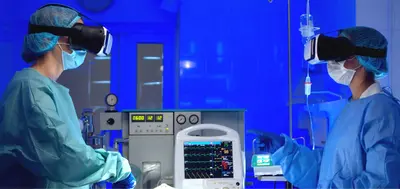Transforming healthcare narratives with tech-driven storytelling
In the realm of healthcare, storytelling plays a crucial role in connecting with audiences, raising awareness, and driving positive change. Stories have the power to evoke emotions, inspire action, and generate empathy. With the advent of technology, healthcare storytelling has taken on a new dimension, allowing for more immersive and impactful experiences. In this blog post, we will explore how to harness the power of technology to create an impactful healthcare storytelling experience.
Virtual Reality (VR) and Augmented Reality (AR):
Virtual reality and augmented reality technologies have the ability to transport viewers into immersive healthcare environments. By using VR headsets or AR-enabled devices, one can create interactive experiences that enable audiences to step into the shoes of patients, healthcare professionals, or caregivers. This can help in building empathy and understanding by allowing people to witness firsthand the challenges and triumphs of those involved in healthcare.
For example, a VR experience could simulate the daily life of a patient with a chronic illness, providing insights into their struggles, treatment procedures, and emotional journey. Similarly, AR can be used to overlay additional information or visuals onto real-world environments, enhancing educational materials or patient consultations.
Gamification:
Gamification is an effective strategy for enhancing healthcare storytelling by incorporating game elements into the experience. Through gamification, one can create interactive and engaging experiences that can encourage HCP’s and patients.
For instance, a mobile app could utilize gamification to encourage users to track their daily physical activity and compete with others, making exercise more enjoyable and fostering a sense of achievement. Additionally, gamification can simulate healthcare scenarios, helping users understand complex medical procedures and ethical dilemmas.
By incorporating gamification, healthcare storytelling becomes a dynamic and interactive approach that empowers individuals to make informed decisions about their health and encourages positive behaviour change.
Interactive websites and apps:
Technology offers a wide range of opportunities to create interactive websites and applications that engage and educate users. Through these platforms, healthcare storytellers can present information in a compelling and interactive manner, enabling users to explore different aspects of a story at their own pace.
For instance, an interactive website could feature multimedia elements such as videos, infographics, and testimonials from patients and healthcare providers. Users could navigate through the website, accessing different sections that cover various aspects of a healthcare issue, treatment options, or patient experiences. This approach encourages active engagement and empowers individuals to delve deeper into the topic.
Social media and online communities:
Social media platforms provide a vast network for healthcare storytelling. Through channels such as Facebook, Twitter, Instagram, and YouTube, healthcare organizations, professionals, and patients can share their stories, raise awareness, and connect with a broader audience.
By leveraging social media, healthcare storytellers can reach a diverse range of individuals, sparking conversations, and fostering a sense of community. Sharing personal stories, educational content, and resources through these channels not only creates awareness but also encourages others to share their experiences and join the conversation.
Data visualization and infographics:
Complex healthcare data can be made more accessible and impactful through data visualization and infographics. By transforming data into visual representations, one can communicate key messages more effectively and engage audiences in a visually compelling way.
For instance, infographics can illustrate statistics, trends, or treatment outcomes, making them easier to understand and remember. Data visualization tools, such as interactive graphs or charts, can provide a dynamic and interactive experience, allowing users to explore data from different angles and draw their own conclusions.
Podcasts and audio stories:
Podcasts and audio stories have gained tremendous popularity in recent years, offering a convenient and intimate way to consume content. One can utilize this medium to share personal narratives, interviews with experts, or discussions on health-related topics.
Through podcasts, one can connect with listeners on a deeper level, leveraging the power of audio to create emotional impact. Listeners can engage with the content while going about their daily activities, making it an accessible format for a wide range of audiences.
Conclusion
In conclusion, technology has revolutionized healthcare storytelling, providing new tools and platforms to create impactful experiences. By embracing virtual reality, augmented reality, gamification, interactive websites, social media, data visualization, and podcasts, healthcare storytellers can engage audiences in a more immersive, educational, and emotionally resonant way. The integration of technology with storytelling holds great potential to raise awareness, drive change, and ultimately improve healthcare outcomes for individuals and communities.
This blog is a playful rendezvous between AI and humans, a captivating blend of digital intellect and good old-fashioned creativity.


-Sep-07-2022-07-17-40-83-AM.webp)
.webp)

